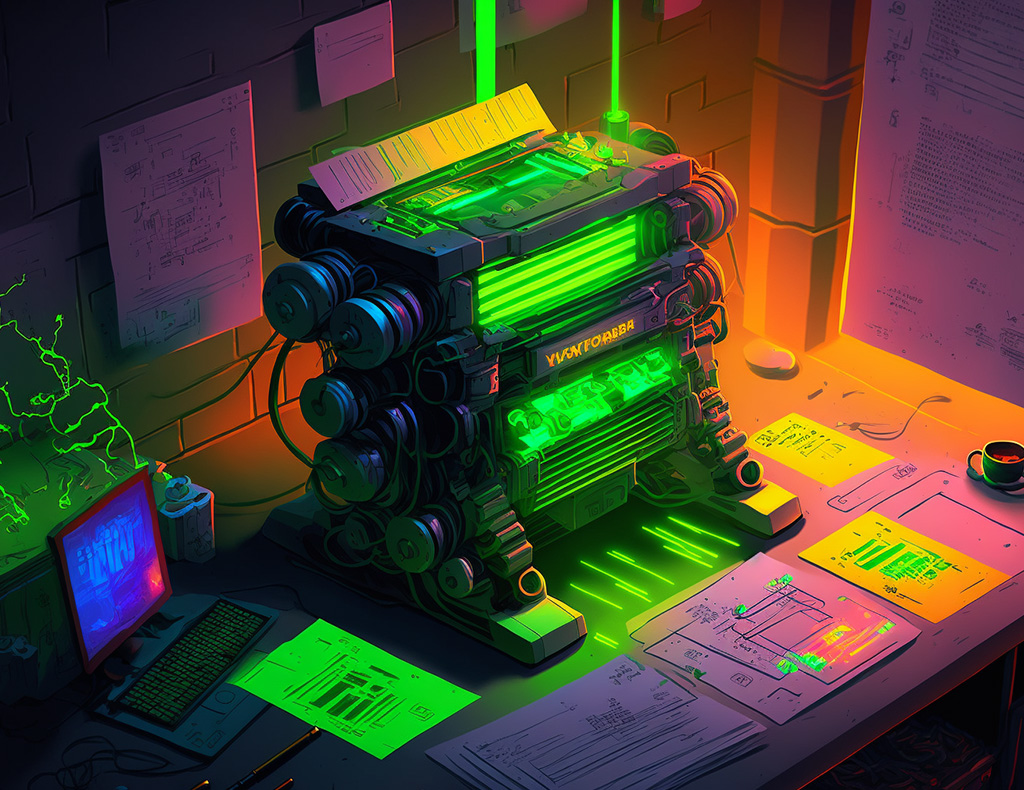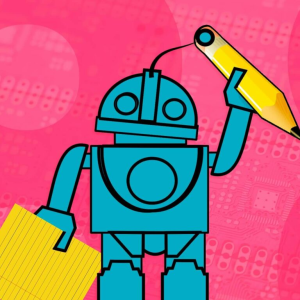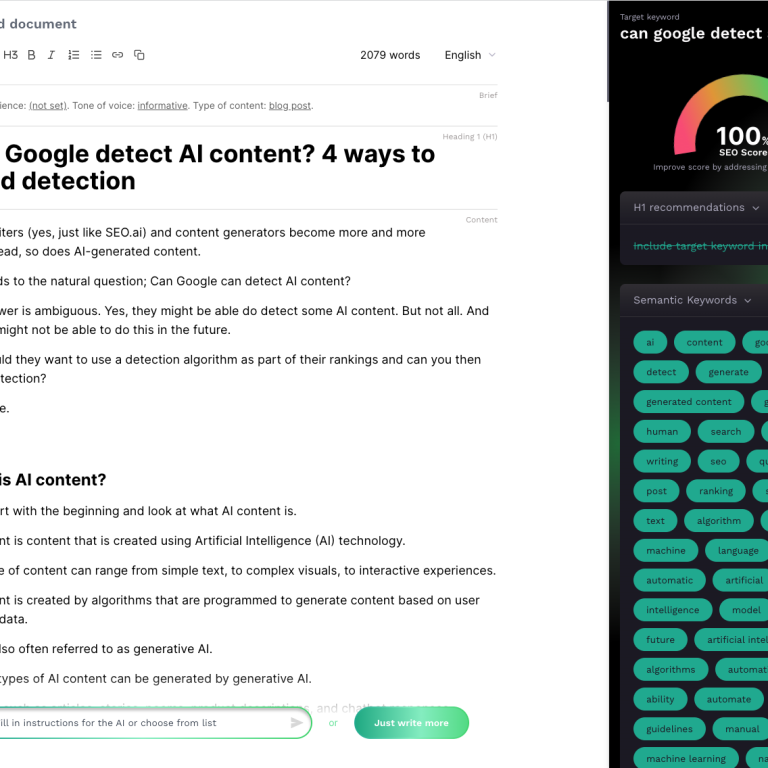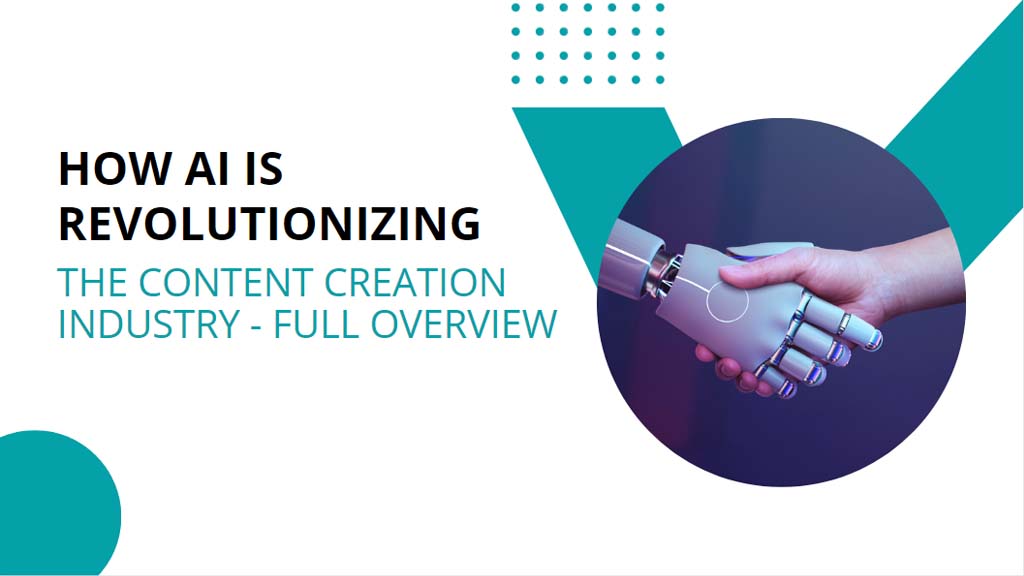Artificial Intelligence (AI) has taken over the Digital Marketing industry by storm, most likely, it will not leave anytime soon. So, what does this mean for Content Writers?
Compared with other areas of Digital Marketing, content writing is more human-centered. Content marketing is a tremendous effort, but using AI tools to help generate content is a different beast. After working for years in content marketing, we can confidently state that it is not simple to modify various forms of media— audio, video, and textual content, to satisfy the unique requirements of the online world.
Content Creation comprises two things—Art & Science. Humans are exceptional at the creative aspects of content marketing, including developing intriguing content and telling stories to customers. But what about science?
Nowadays, navigating the science and digital world can feel like dancing on a tightrope. With the rapid growth of Artificial Intelligence (AI), staying ahead of AI Detection algorithms used by websites and search engines is becoming more challenging. The stakes are high: Users who fail to escape AI-generated content detection face significant issues.
So buckle up because this blog gives readers all the AI Detection Tools they need to navigate this complex path easily. But do not use it for fully fledged content because Google can Detect AI Content, and your account website might get suspended!
As the saying goes— Knowledge is power, and knowing how AI functions will enable people to make wise choices when building their online profile. So before we start with “How To Avoid AI Detection,” let’s discuss What AI Content is.

What Is AI Content?
AI Content is content that is written or produced using AI technology. This content might include simple text, complex images, and interactive activities, and this technology helps confirm the legitimacy and accuracy of a content piece.
These tiny machines take your initial input and produce something that resembles the original content. Algorithms programmed to create content based on data or user input have AI content. This is also frequently referred to as generative AI, and Generative AI may produce various kinds of AI content.
- Image: illustrations, photos, and illustrations
- Text: poems, stories, product descriptions, blogs, articles, webpage content, and chatbot
- Video: advertisements, animated videos, and movie clips
- Voice: story narration, dub voiceovers, and speech for virtual assistants.
- Audio: speech, music, and sound effects
- Augmented Reality (AR) and Virtual Reality (VR): animations, 3-D models, and environments
- Natural Language Processing: sentiment analysis, language translation, and summarisation.
- Coding and Programming: web apps, software, and games.
- Scientific Data and Prediction: scientific research, medicine discovery, weather forecasting
- Financial Data and Predictions: financial reports, stock predictions, and risk analysis
When SEO executives talk about Google and AI Detection, they think texts may be identified and AI-generated. But music, videos, and images can also be AI-generated, which are ranking criteria for traditional web content.

What Are AI Detection Tools?
In simple words, textual format contents are checked by a Realistic AI Detection Tool or system to detect if a human or AI created it. These technologies may consider the complexity degree, grammar, syntax, general readability, and text coherence.
For instance, the tool may determine whether the text was written by an AI like Chat GPT or Jasper by looking at the language used and the level of text complexity. The AI-generated text might be more formulaic and repetitive than human-written text, yet it also needs more complicated hints of human language.

Furthermore, AI-generated texts may occasionally include mistakes or inconsistencies that are less likely to be present in human-written material. The ChatGPT AI Detection Tool could tell if a human produced a text by examining several linguistic and stylistic aspects of the text.
For instance, human-generated content might be more refined and varied than material produced by an AI and contain more formal language and cultural references that are particular to the human experience.
The Workaround:
With the development of AI technology, the application of Realistic AI Detection Tool to identify AI-generated content has drawn more and more attention in recent years. AI has the potential to completely transform content creation thanks to its capacity to produce incredibly realistic text, photos, and videos. This raises questions about the possibility of exploiting AI to create deceptive or hateful content. This has caused great anxiety, especially for student reports and take-home tests.
ChatGPT from OpenAI is not the only player in this arena. Numerous specialized AI-powered tools are available for creating and identifying content. So, here’s a quick experiment to learn more about possibilities.
How Google AI Detection Works?
If we are working on texts created by an AI system, Google uses several methods to attempt to identify text. When detecting texts produced with ChatGPT or other Free AI Detection Tools, there are many platforms to pick from. SEO agencies are the main users of such tools, as their primary goal is to prevent their writings from being plagiarized.
Suppose they need to make use of these detection tools. In that case, Google will likely find plagiarism or AI-generated content, which might result in penalties for the website hosting the content and the work being considered useless.

First, it is important to know how AI may produce text to understand how. Natural Language Generation (NLG) is used to create AI-generated text. NLG is a sort of Artificial Intelligence (AI) that uses algorithms to produce language that resembles that of a human from data.
The algorithms must first be trained on a massive corpus of data to produce language that closely resembles the data. By examining indicators like the text’s structure, grammar, and syntax, Google can also utilize machine learning techniques to identify material that AI created. In other words, these algorithms can identify patterns in the text that point to the presence of AI material.
Several factors could be used to determine that Google’s AI produced this text:
- The text’s structure is repetitive, using the exact words and phrases repeatedly.
- Although the grammar and syntax are proper, there could be less variation and complexity than in naturally produced human text.
- Although the writing may be very coherent, it needs more context and refinement of human-written material.
We also witness many free AI Tools and Free AI Detection Tool producing large text walls. Or if a writer does not combine AI with a human connection. This is merely terrible content material, and the reason Google devalued it is not that it was produced using AI but because it needed to be of higher quality and provide a better user experience.
Why Avoid Google Detection?
There is still a lot of dispute regarding how to avoid Google detection.
Someone is seeking guidance on How To Avoid AI Detection in a Facebook group. But why would someone want to hide that a machine was used to create something?
They can fall under three different categories:
- SEOs who still hold the outdated belief that Google is against AI content
- SEOs who are uncertain and feel safer if Google cannot identify the content as AI
- SEOs who employ AI for spamming activities
SEOs falling into one of the three groups feel secure knowing they won’t be penalized by Google’s ranking algorithms by trying to hide the fact that generative AI did produce the text. I occasionally hear that some people, mostly in group 2 above, worry that it might come in the future even if Google doesn’t penalize it now.
In the previous section, downgrading content based on whether an AI was engaged in its creation loses value over time. The distinction between AI and humans will continue to erode as AI improves. Similar to Google’s stance on AI, the trend is shifting away from that.

How To Avoid AI Detection For Content Creation?
It is becoming challenging to Bypass AI Detection. AI-generated text and images might be accurate and valuable, but we must ensure they are genuinely AI-generated before using them in practical contexts. Since AI Detection Tool Free ChatGPT’s introduction as an interface to its ordinal language models, up to GPT-4 at last check, many generative AI Detection Tools and techniques have evolved to accomplish just that.
Content managers in businesses, SEO companies, and universities must know how they can be tricked. They must understand how writers can use their content quality control systems and AI content detection tools. One of the most effective ways to Bypass AI Detection is to use AI Detection Chat GPT, Jesper.ai, to help create highly original content or use the same tools to rewrite current content.
Therefore, this blog sheds some light on simple approaches. How could you conceal your material if you belong to one of the three groups so that Google won’t be able to find it?
1. Prompt The AI To Generate Texts That Are Less Likely To Get Detected
One approach to disguise the texts at first is giving the AI varied instructions so that it produces writing that doesn’t look entirely artificial. Latest language models are specialized at such things. The created text will be less predictable and more challenging for other machine learning algorithms to discover if more advanced language generation approaches are used, such as those considering context, tone, and style.
Another option is to use prompts with a stronger emotional undertone:
“Give the AI prompts with deeper emotional context rather than the ones that don’t,” like “Write a letter from mother to her son who is moving abroad for studies.” Alternately, employ prompts with more imaginative context, such as “Write a poem that captures the emotion of falling in love.” The prompt, “Rewrite the following as a 24-year-old human would,” produced the most outstanding results in my experiment with various prompts and detecting tools.
2. Use a Different Tool To Disguise The Texts as AI-Generated
Rephrasing the texts by another AI writer is a frequently used technique for hiding that it is created by an AI.
The Quillbot is frequently mentioned as the preferred platform for this. This tactic is quite strange—rewriting material from one AI using another. This should only improve if the prior AI platform’s tool or output were subpar. After that, the Quillbot is told to rephrase in a specific way. Similar to how we as humans used to rewrite at a certain age.
3. Use a Tool with Robust AI Engine
The text output will get better and better as the language models develop. Additionally, it will take more work to identify because the text will be more varied and appear more authentic.
Therefore, it is less likely that other machine learning algorithms will detect you the more often you use tools that use more sophisticated models like GPT-3 (both SEO.ai and ChatGPT use GPT-3.5), which can generate more human-like content. And it will only rise once the GPT-4 is out later this year.
4. Add Personal Touch To The AI-Generated Content
If the above 3 tactics dont work Combining human and AI writing is the final means of evading discovery, and this implies that you can have a human writer alter a work generated by an AI to make it sound more natural.
Alternatively, you may use AI to speed up the writing of your post while still including your original content. This is the approach I favor. You may combine the precision and speed of AI writing with the fluidity of human handwriting to achieve the best of both worlds.

By combining human and AI, you may ensure that the text appears less artificially generated and more naturally written. This is a terrific approach to guarantee that no one will recognize your content as AI-generated.
Additionally, it is simpler to correlate with the most recent “Experience” component that Google added to their E-E-A-T (Experience, Expertise, Authority, and Trustworthiness) system for assessing material.
5. Avoid Repetition of Words & Phrases
The fifth advice is to avoid recurring words or phrases when interacting with ChatGPT.
Due to its dependence on patterns and templates that result in formulaic language, artificial intelligence-driven discourse is frequently detectable. Keep your texts as natural-sounding as possible to prevent AI detection by avoiding robotic-sounding texts. Diversify your word choices and sentence structures to avoid using repetitive or conventional terminology.
6. Don’t Let The Tool Write Everything
To prevet AI Detection, It is advised to divide the text into smaller chunks and produce each portion individually when using AI Detection ChatGPT. This will make the information seem more authentic and less likely to be labeled as computer-generated.
It is possible to further enhance the text’s quality by reviewing and editing each section, making it less likely that AI system detection software will pick it up. Creating pieces separately also enables you to include details and variations common in human dialogue but uncommon in a lengthy article produced by an AI program.
7. Re-write Your Content
The seventh stage in avoiding ChatGPT AI Detection is using tools like QuillBot to edit the text without changing its core meaning. QuillBot is a writing tool powered by artificial intelligence that may be used to rephrase or paraphrase textual content.
With the help of Quillbot, AI-generated texts can sound less robotic and more human-like. You can reduce the likelihood that the text will be recognized as computer-generated information by revising it.

Enter the resulting text into QuillBot and select the level of rewriting you desire to apply. The tool will then produce a fresh draught for the reader with the same meaning as the original but a different wording. This procedure can be repeated numerous times to create a whole new version.
8. Check For Content Accuracy
One of the most significant drawbacks of AI is that any information generated programmatically could be more reliable.
You still have a lot of work to do, including research and fact-checking, etc. Your reputation and trustworthiness will be questioned if your content contains inaccurate facts.
9. Experience, Expertise, Authoritativeness
Whether you share a story from your own experience or someone else’s, Google wants you to have some background knowledge of your writing content as a writer or content provider. For instance, if you are writing a product review, you should have used the item at least once.
You must have information or expertise regarding the subject you are researching. People are likelier to believe health advices of someone from a medical background than usual bloggers.
Your content should be a reliable source of authoritative information. This entails creating a topical outline for all the topics you cover. Remember that Google can only browse your website for information and establish links between entities; it cannot “read” the material.
10. Trustworthiness
Google wants you to develop reader trust and a trusted online presence. You can accomplish this by providing accurate information and demonstrating the legitimacy of your enterprise by having the following:
- Email addresses of multiple departments
- Telephone number
- Business profile on Google
- About Us and Company Team page
- Official Local Address
Bottom Line
Chat GPT and other Free AI Detection Tools can be practical tools to produce original and unique content. However, adding your flair is crucial to avoid making your writing appear robotic, formulaic, or susceptible to AI detection.
This entails reducing things into manageable parts, adding entertaining tales to liven up your writing, and avoiding dull and repetitious terminology.
Always remember: even though AI Detection Tools might be a great tool in your quiver, nothing compares to the originality and spirit a human writer brings. So start writing and let your imagination go wild!
We hope this blog answered all your queries and cleared some misconceptions about AI Tools. To get original and unique human-written content, contact SEO Discovery, and we will get back to you ASAP!



Add a Comment